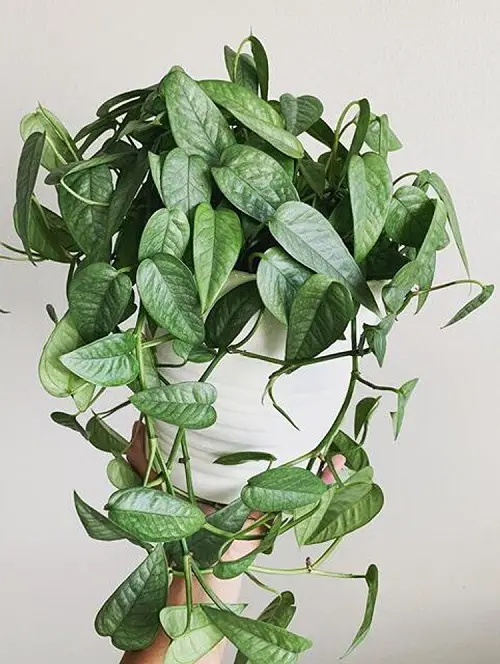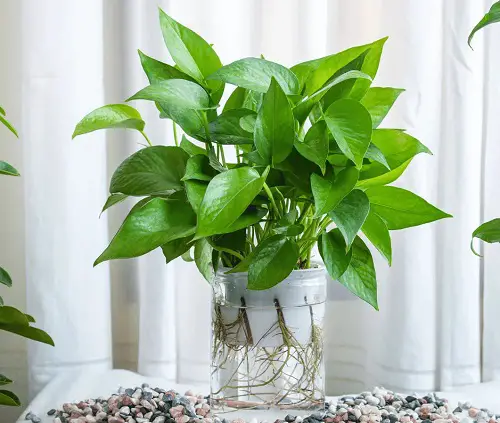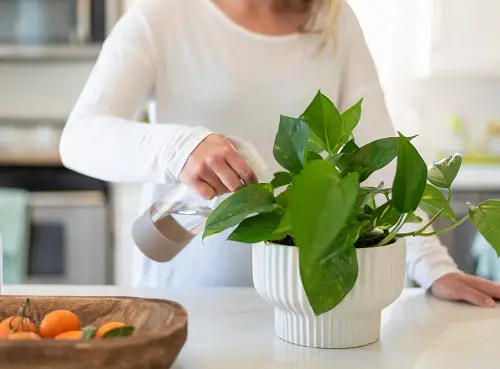Want to know How Long Does a Pothos Plant Live? Find the answer in this informative post to ensure it stays healthy for long!

Not sure about How Long Does a Pothos Plant Live? Learn about the right growing conditions, care tips, and common problems to avoid to ensure your pothos plant can potentially outlive you.
Learn How to Grow a Pothos as a Tree
Pothos Plant Profile
Pothos (Epipremnum aureum) is a part of the Araceae family, also known as the Arum family, along with other popular houseplants such as Monstera, Anthurium, and Peace Lily. These plants are sought after for their attractive foliage in a range of colors and sizes and are known for their easy maintenance.
In some regions, Pothos is called the Money Plant due to its supposed ability to bring good luck and financial prosperity to its owner. However, it is also known as Devil’s Ivy because of its invasive nature.
How Long Do Pothos Plants Live?
Determining the actual lifespan of a houseplant can be challenging since they do not have a specific natural lifespan range. Its lifespan can vary from 2 years to 10 years, or even longer, depending on its growing conditions and the quality of care it receives.
As with all plants, different parts of the Pothos will age over time. Leaves may turn yellow and fall off, and stems may become smaller. However, if the plant is given proper care and ideal growing conditions, new leaves and stems will continue to emerge, extending the potential lifespan of the plant to an indefinite period.
However, there is no guarantee that a Pothos plant will live forever. Inadequate growing conditions, neglect, or pest and disease infestations are a few factors that could contribute to the plant’s eventual demise.
Fortunately, this also means that with the right care, your Pothos could potentially live for the same amount of time as you or even longer.
Limitations of the Lifespan of Pothos

When a plant grows too tall, it can become unsustainable for itself. Plants have a special tissue called “meristem” located at their tips and roots that allows them to grow indefinitely in height and width.
In the case of the pothos, if it grows too tall, it may not be able to receive enough nutrients and water from the soil to sustain its foliage at the top. This could cause the plant to deteriorate. To prevent this, occasional pruning is necessary to keep the pothos healthy and thriving for up to ten years or more.
Can Pothos Live in the Water Forever?

Pothos is capable of living indefinitely in water, provided that it is given the appropriate environmental conditions, such as proper lighting, temperature, fertilization, and aeration.
As an aquatic plant, Pothos thrives in a water-based environment. Propagating it by rooting a stem in water is a simple process. Moreover, Pothos has become increasingly popular in aquariums due to its ability to oxygenate and filter water.
How to Extend The Life Of Your Pothos?
To ensure a long lifespan for your Pothos, it is important to provide appropriate care and maintain suitable environmental conditions.
1. Right Positioning

It’s important to keep your Pothos plant indoors rather than outdoors, as outdoor conditions can be too harsh for it, especially the harsh afternoon sunlight.
Place your Pothos in a bright spot with plenty of indirect light. Make sure it stays protected from the long exposure to the harsh afternoon sun.
2. Use the Right Soil
Soil quality is crucial for the longevity of your pothos plant, especially if you are growing it in soil. Using plain garden soil or a cactus mix can significantly reduce the lifespan of your pothos.
Garden soil can retain too much water, while a cactus mix does not hold enough water. These conditions are not ideal for your pothos plant. If you want your pothos to thrive for generations, it is recommended to use a proper potting mix.
The ideal soil mix for pothos consists of equal parts of peat moss, perlite, and compost or coco coir. This blend allows for good aeration and drainage, as well as enough organic matter to provide nutrients for the plant. Additionally, it is important to use slightly acidic soil with a pH of 5.0-6.5.
3. Water Correctly

Overwatering is a common issue that can harm plants even more than underwatering. This is especially true for Pothos plants, as too much water can quickly lead to their demise.
Water your pothos when the top of the soil is dry to the touch, about once a week. Allow the soil to dry out between waterings to avoid overwatering. If you notice the leaves turning yellow or wilting, you may need to adjust your watering schedule.
4. Re-pot When Required
Healthy plants continuously grow, meaning that the roots will gradually expand into the soil. Eventually, they will fill up the pot, leaving no room for further growth. Without space to expand, the roots will start to circle around themselves and exit through the drainage holes, causing root deformities.
1. Remove your pothos from its current pot and gently shake off any excess soil from the roots.
2. Prune back the roots. Cut away any dead or diseased roots. If you have a very root-bound plant, you can make several cuts to the roots.
3. Place the plant in a one-size bigger new pot. Fill the pot with fresh potting soil, making sure to cover the roots completely.
5. Pruning

Pothos plants are known to grow at an impressive pace and can become unmanageable if left unattended. Although this may not directly impact their lifespan, it can cause stress on the plant, leading to stunted growth and root damage.
Fortunately, pruning is a simple and effective solution to this problem. When done correctly, pruning can stimulate new growth at the site of the cut, keeping the plant at a manageable size and improving its appearance.
Tip: Additionally, don’t toss away the cuttings after pruning. Trim them, place them in a glass of water, and watch as they develop roots and grow into new Pothos plants, allowing you to expand your collection or share them with friends and family.
6. Prevent Pests & Diseases
Mealybugs and scales are the two most prevalent insect pests that can affect pothos plants in household settings.
Although diseases are not as frequent, Pothos plants can be affected by root rot and leaf spot. Prevention is crucial when it comes to diseases. Proper care and prompt removal of any problematic foliage can help prevent the spread of disease. Once a plant is infected, it is often best to dispose of it rather than risk spreading the disease to other indoor plants.
7. Appropriate Fertlizing
Overfeeding your pothos can actually harm their longevity. While an underfed plant can be corrected, the same cannot be said for an overfed one.
Fertilizing pothos is an important part of ensuring healthy, lush foliage. Pothos need to be fertilized every two to three weeks during the growing season, using a balanced fertilizer like 20-20-20.
It’s best to dilute the fertilizer to half-strength to prevent burning the roots. Additionally, always water the plant thoroughly before and after fertilizing.
Check out the Best Homemade Fertilizers for Pothos
How Long Does a Pothos Plant Live – Conclusion
By providing the appropriate care and attention, you can ensure the longevity of your Pothos for as long as you desire – possibly even outliving you!
Though there are other houseplants with longer lifespans, Pothos remains one of the most beloved and effortless indoor plants to nurture!


